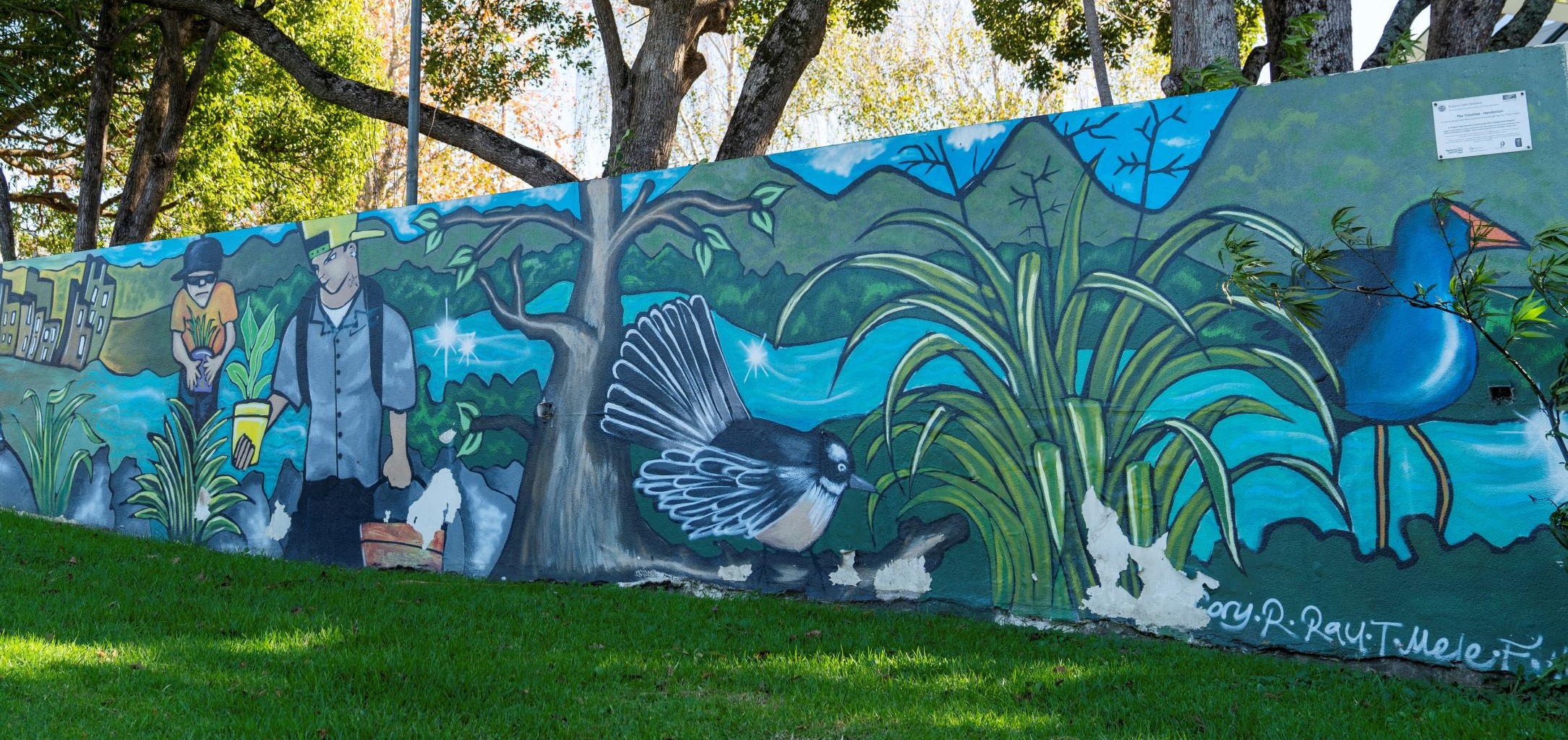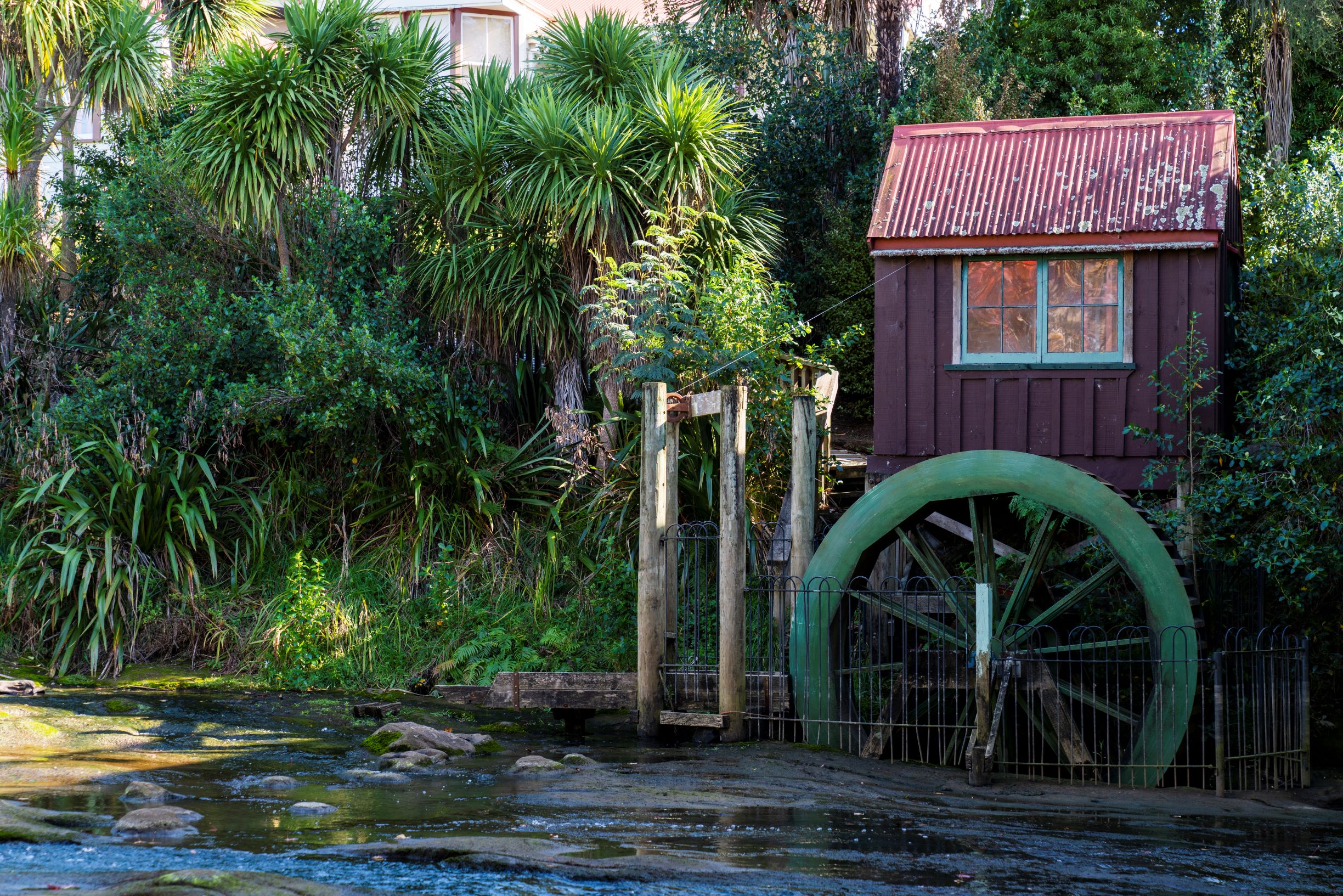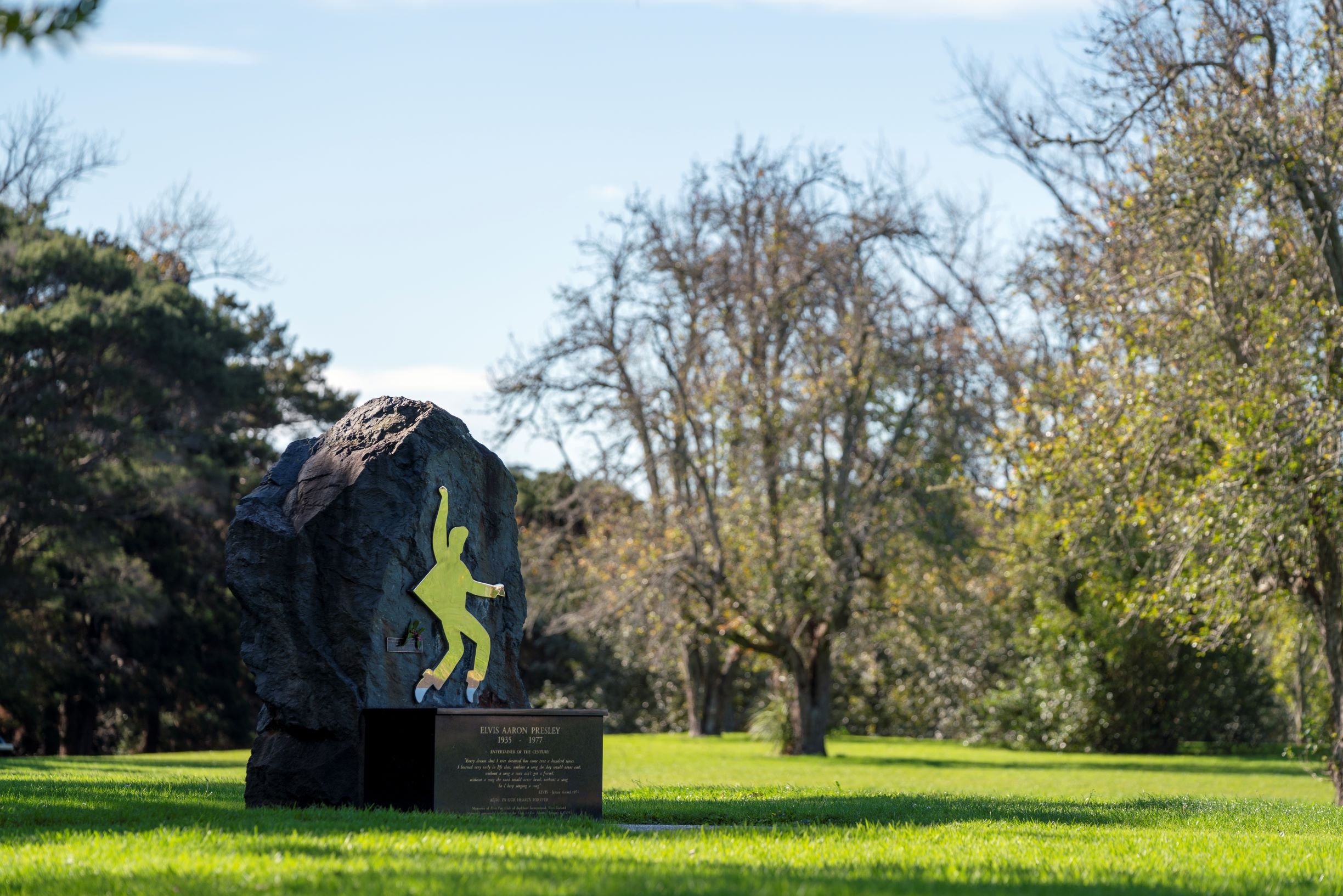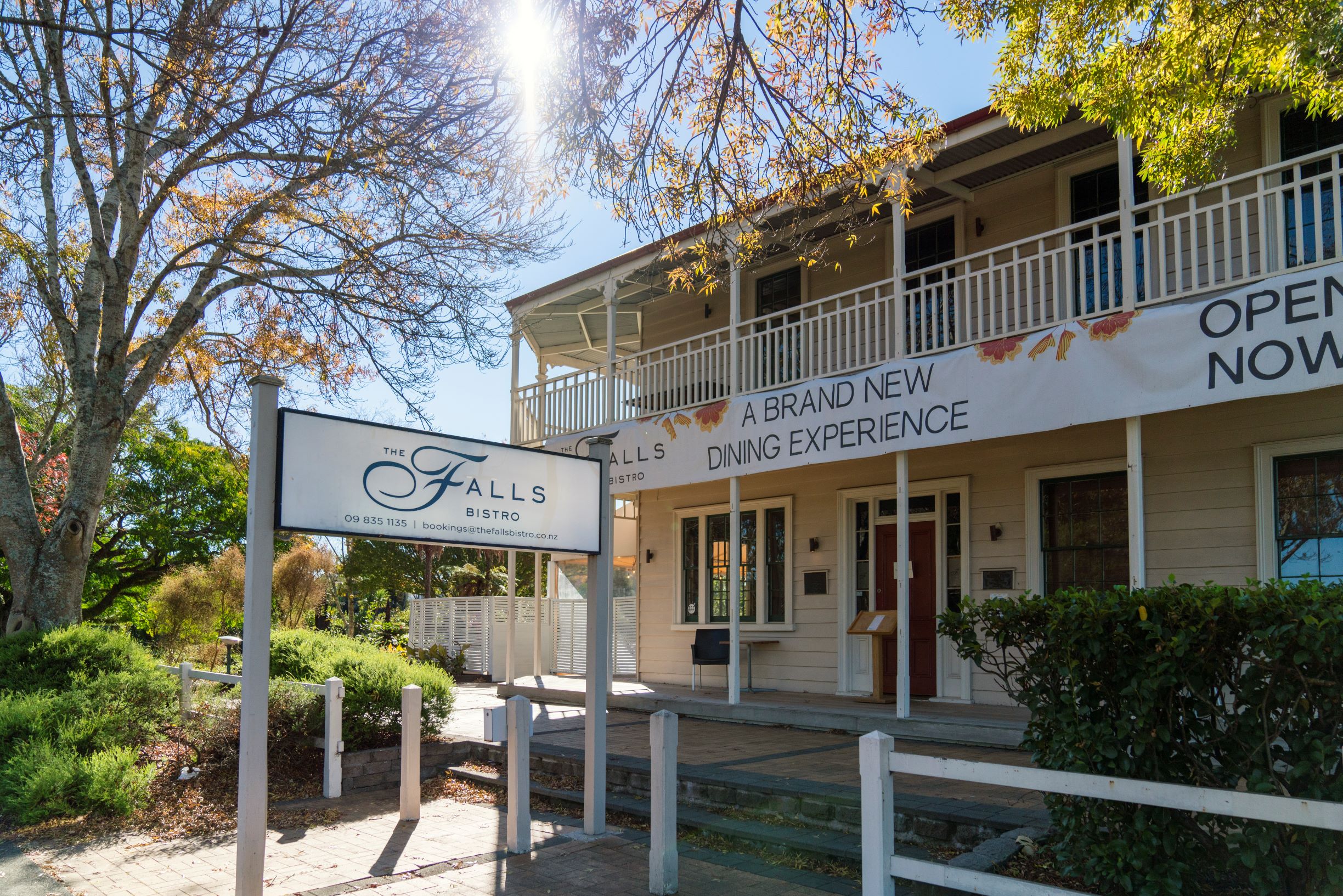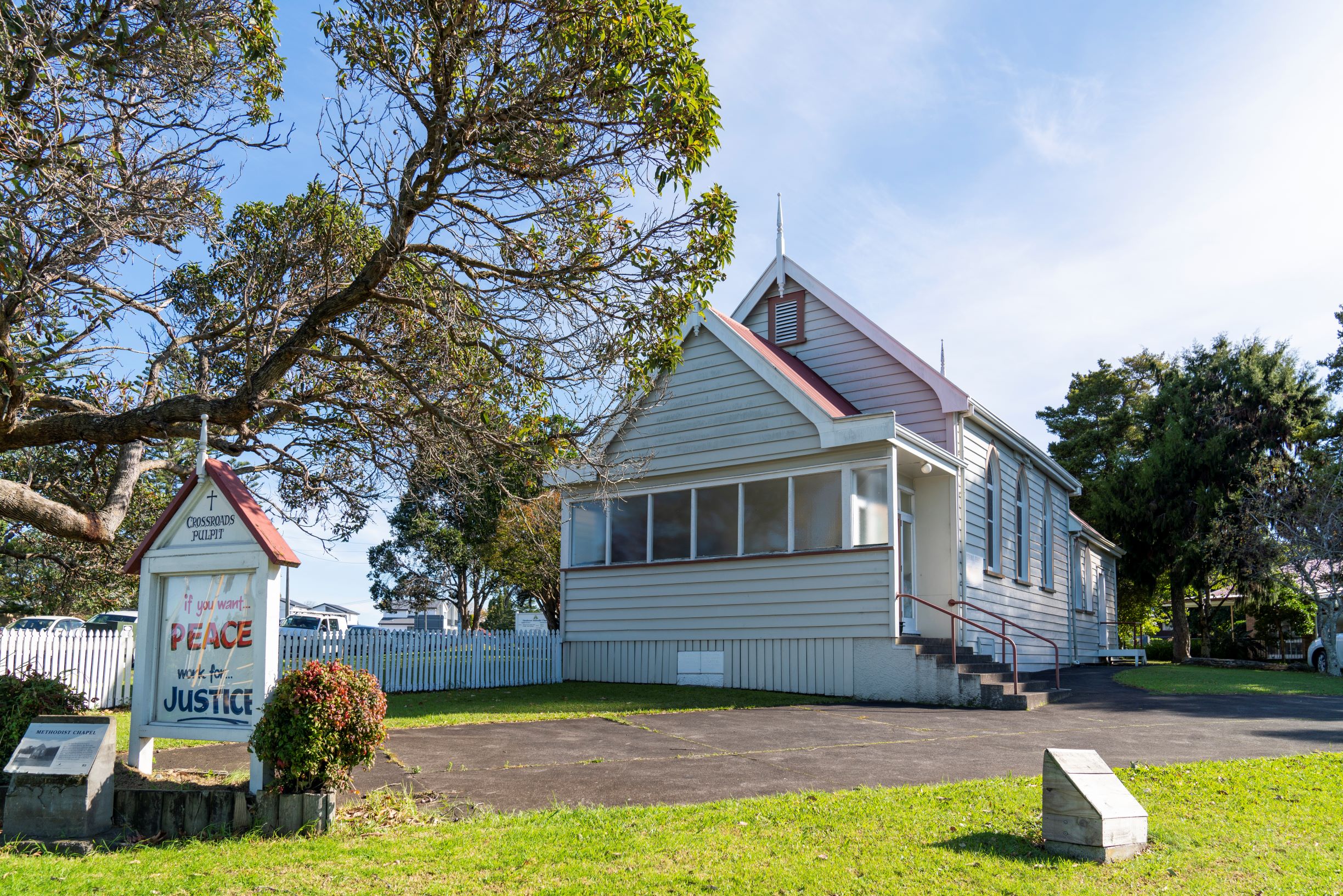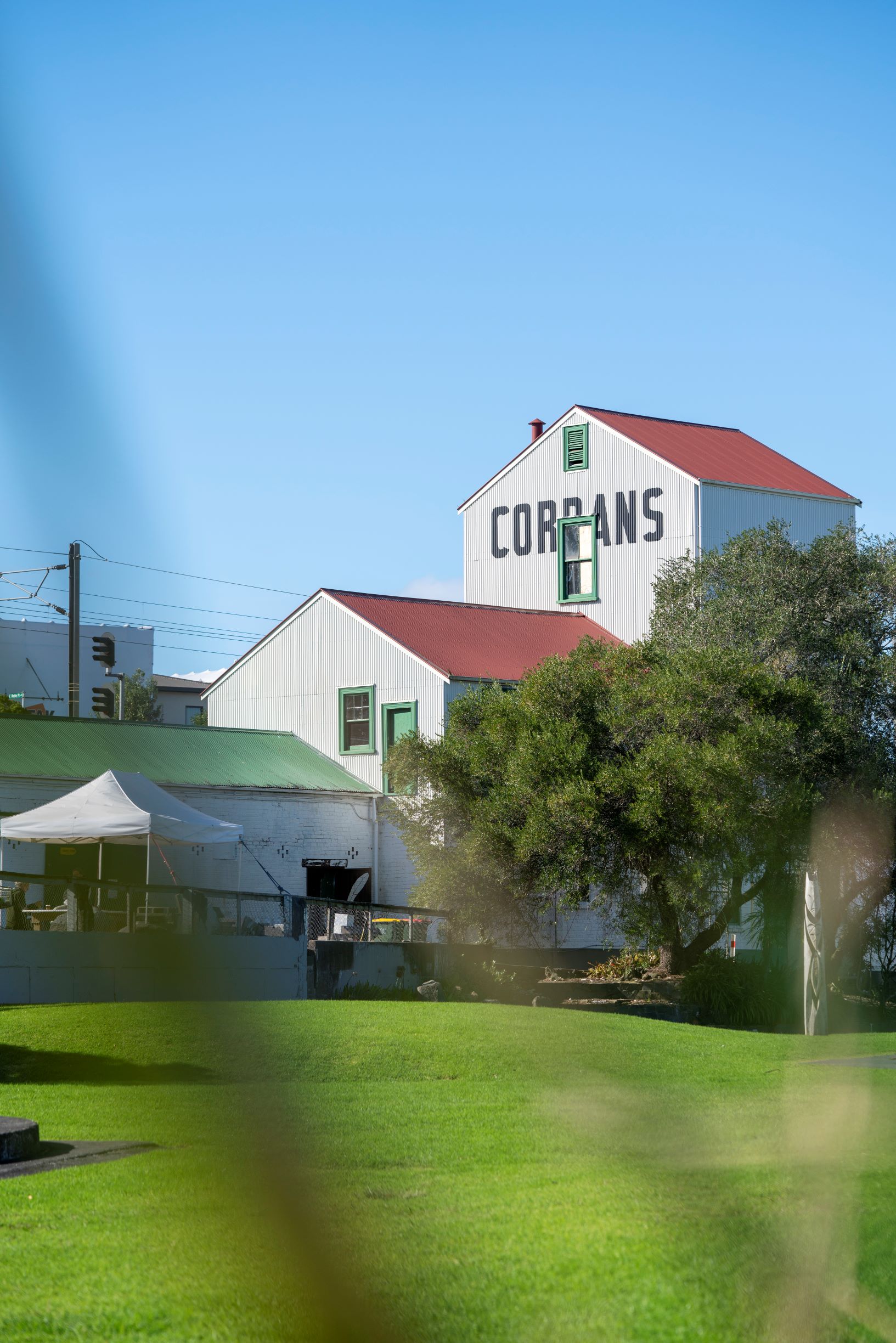Local Walks in Henderson
There is so much to see in the Henderson district… why not go for a walk around the community to connect with our heritage? Walking is a great way to stay in shape and in the meantime, you can discover the little hidden gems which make us who we are today.
The Henderson Heritage trails were a joint venture by the West Auckland Historical Society and the Waitakere City Council as a contribution to the Henderson 150yr Commemoration (1844 – 1994). The Henderson Trail is divided into two loops of about 40 minutes walking time, each with an optional 10-minute extension. Both loops start and finish at the Henderson’s Mill Cottage. For details on the locations along Loop A and Loop B please check the map.
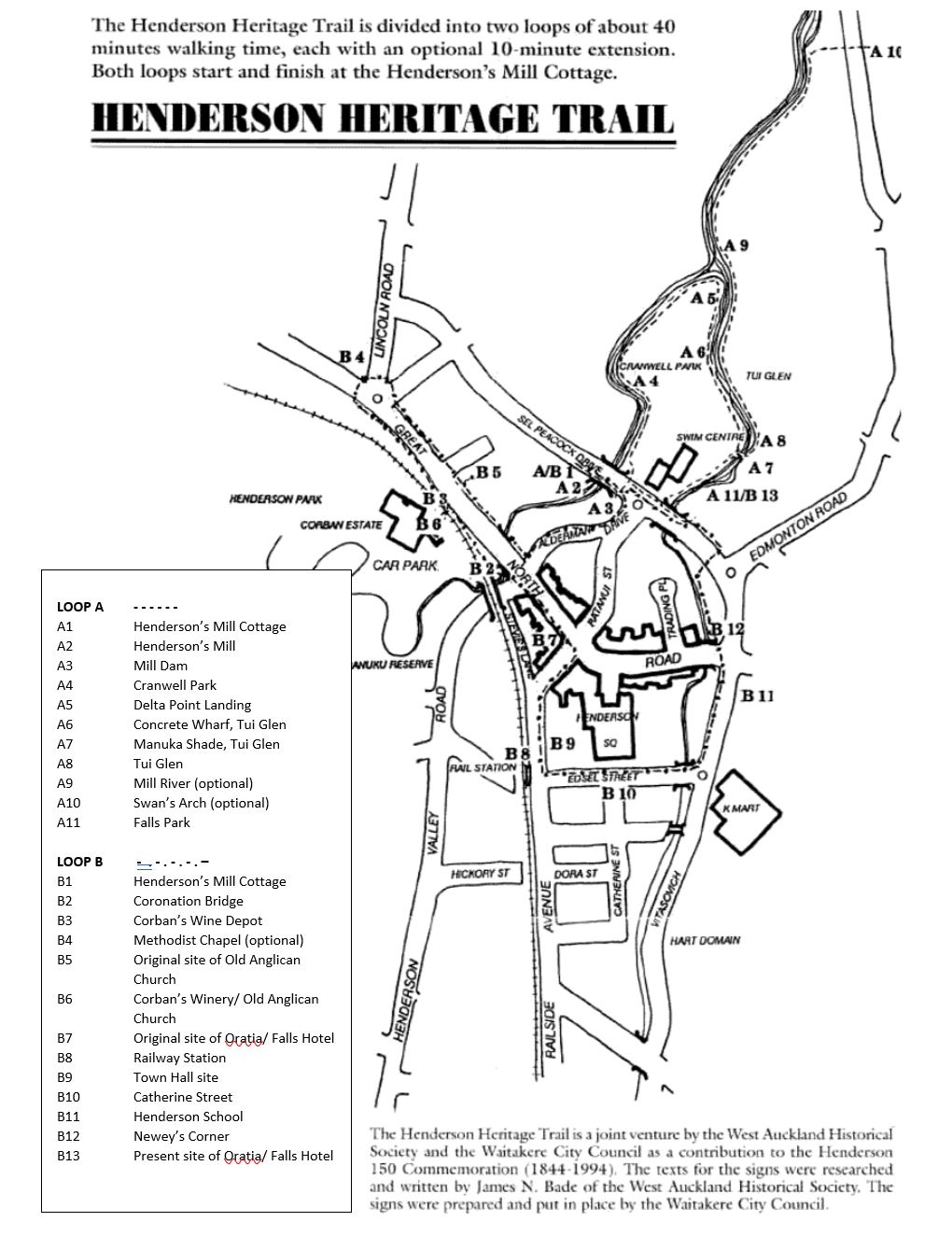
Trail Landmarks -Loop A
A1. Mill Cottage
The original part of this cottage is believed to have been built about 1848 as the mill cook house. In 1875 it became the second Henderson’s Mill school room. After 1880 it is believed to have been converted into a four roomed cottage.
In the 1930s it was extended by the Corban family, who gifted it to the City in 1993, when it was restored to its present condition by the West Auckland Historical Society.
A2. Henderson’s Mill
On 8 October 1844, Governor Fitzroy proposed a Crown Grant of half the land claimed by Henderson and Macfarlane, and the partners commenced milling activities in this area. They established a timber mill on this site about 1847.
A3. Mill Dam
A wooden holding dam was set up here in the late 1840s to contain the kauri logs brought down from further upstream. The foundations of the dam, which also powered the 5-metre water wheel, are still visible in the stream bed.
A4. Cranwell Park
This park was originally part of Thomas Henderson’s farm. About 1900 it was developed into an orchard by Ben Cranwell, whose father Robert had founded the first commercial orchards in Henderson in the Lincoln Road area in the 1880s.
A5. Delta Point Landing
This landing, the remaining supports of which can be seen in the bank below the sign, was, until the arrival of the railway in 1880, the main means of communication with Auckland for the early mill settlement, as Great North Road was notoriously unreliable.
A6. Concrete Wharf, Tui Glen
The concrete wharf was the focus of many attractions at the Tui Glen Motor Camp and Amusement Park in the 1930s. The derrick, used to raise and lower canoes and dinghies, was part of the original wooden wharf built in 1924.
A7. “Manuka Shade”, Tui Glen
This cabin, built in 1908, is a good example of a simple colonial cottage. Originally situated at 21 Henderson Valley Road, where the present Wilsher Village now stands, it was moved to Tui Glen in 1964.
A8. Tui Glen
This area, originally part of Thomas Henderson’s farm, was bought by Claude Brookes in 1915 and developed into New Zealand’s first motor camp. Known as Tui Glen Motor Camp and Amusement Park, it was opened on 12 December 1924.
A9. Mill River
Henderson’s Creek was shown on early maps as “Mill River”, as kauri timber was shipped down the river to the harbour from Henderson’s Mill. The 1854 “Pandora” chart shows two buildings on either side of the river at this point, possibly early sawing stations.
A10. Swan’s Arch
The lawyer Henry Swan bought land here in 1898. In 1904, telling his friends that he was embarking on a solo journey around the world, he sailed the “Awatea” here, planted fruit trees, and lived on board as a recluse for the rest of his life. He built the brick arch in 1909; the underground shelter was used mainly for fruit storage.
A11. Fall’s Park and site of the Falls Hotel since December 1996
The “Falls Recreation Ground” was purchased and developed by the Henderson Town Board from 1923 to 1925, and was a popular picnic area, playground, swimming hole and overnight anchorage during the 1920s and 1930s. It was later occupied by the Henderson Women’s Bowling Club.
A12. The original site of the Oratia / Falls Hotel
This hotel was built in 1873 to provide accommodation for the travelling public. Originally named Oratia Hotel after the Oratia stream, the hotel’s name was changed in 1890 to Falls Hotel, after the Waitakere Falls, which were a major tourist attraction in the late nineteenth century. The first proprietor was “Shepherd” John McLeod, Thomas Henderson’s farm manager.
Trail Landmarks -Loop B
B1. Henderson Mill Cottage
The original part of this cottage is believed to have been built about 1848 as the mill cook house. In 1875 it became the second Henderson’s Mill school room. After 1880 it is believed to have been converted into a four roomed cottage.
In the 1930s it was extended by the Corban family, who gifted it to the City in 1993, when it was restored to its present condition by the West Auckland Historical Society.
B2. Henderson Mill
On 8 October 1844, Governor Fitzroy proposed a Crown Grant of half the land claimed by Henderson and Macfarlane, and the partners commenced milling activities in this area. They established a timber mill on this site about 1847.
B3. Methodist Chapel
The first church to be built in Henderson district, the Methodist Chapel was opened on Christmas Day 1898. People from many denominations were involved in its early worship life, with the Presbyterian church holding services here from 1899 to 1911. Services had previously been held in Henderson’s Mill School. From 1858 to 1876 this was the site of the first Henderson’s Mill Racecourse.
B4. Original site of the old Anglican Church
St. Michael’s Anglican Church was dedicated on 13 September 1914 by the Bishop of Auckland. The altar was made and donated by the sons of Rev. R. C. Boler. When the present church was built in 1962 the old church was moved back from its original site to make way for it. In 1997 the old church had yet another move when it was taken over the road to the Corban Winery grounds.
B5. Corban’s Wine Depot
A prohibition majority in 1909 meant that the selling of wine in Henderson was illegal, but as the Henderson no-licence boundary ran along the railway line, the Corban’s built a depot here to sell their wine. Boundary changes later closed this depot.
B6. Corban’s Winery – present site of the old Anglican Church.
In 1892 the winemaker Assid Abraham Corban (1864-1941) emigrated to New Zealand from the Lebanon. Ten years later, having been joined by other members of his family, he established a vineyard here which was to become Henderson’s best-known winery. The wine cellar, built in 1907, is the oldest industrial building in Henderson, while the 20-room homestead, built in 1923, is Henderson’s finest family home.
B7. Coronation Bridge
So named because it was opened in 1911, the year of King George V’s Coronation, this bridge replaced an earlier wooden bridge over the Opanuku Stream and remained in use for over fifty years. The remains of other road and rail bridges may be seen in the vicinity.
B8. Railway Station
The coming of the railway in 1880 hastened Henderson’s development and helped its transition from a mill settlement to the centre of an agricultural and horticultural district. A passenger platform was installed in the 1890s and in 1905 Henderson became an officered railway station. The present station was built in 1912.
B9 Town Hall Site
Henderson’s first civic hall was a kauri hall built on this site in 1896, which burned down thirty years later. In its place the Henderson Town Board constructed a new reinforced concrete Town Hall, opened in January 1927, which later became the Civic Theatre. Forty years later it, too, was destroyed by fire, on 20 July 1967.
B10. Catherine Street
All the central Henderson streets were named after members of Thomas Henderson’s family. Apart from Catherine Street, named after Thomas Henderson’s wife Catherine (1811-1867), all have been renamed or no longer exist. Other streets named after the family were Thomas, Henry, John, Mary and George Streets.
B11. Henderson School
Henderson School opened in 1873. Classes were held in the Mill reading room and cookhouse until the school moved to its present site, donated by Thomas Henderson, in 1880. The first teacher at the new site, Miss Helen Hanson, lived in a house which once stood in the Baptist Church car park across the road opposite this sign.
B12. Newey’s Corner
Miss Eileen Newey, who lived on this corner, was a teacher at Henderson Primary School, where she taught for eleven years, finally as infant mistress from 1959 to 1963. She remained a well-known local identity right up to her death in 1987. She left her property to the Henderson Borough Council for development as a park.
B13. The original site of the Oratia / Falls Hotel
This hotel was built in 1873 to provide accommodation for the travelling public. Originally named Oratia Hotel after the Oratia stream, the hotel’s name was changed in 1890 to Falls Hotel, after the Waitakere Falls, which were a major tourist attraction in the late nineteenth century. The first proprietor was “Shepherd” John McLeod, Thomas Henderson’s farm manager.
B14. Fall’s Park and site of the Falls Hotel since December 1996
The “Falls Recreation Ground” was purchased and developed by the Henderson Town Board from 1923 to 1925, and was a popular picnic area, playground, swimming hole and overnight anchorage during the 1920s and 1930s. It was later occupied by the Henderson Women’s Bowling Club.

